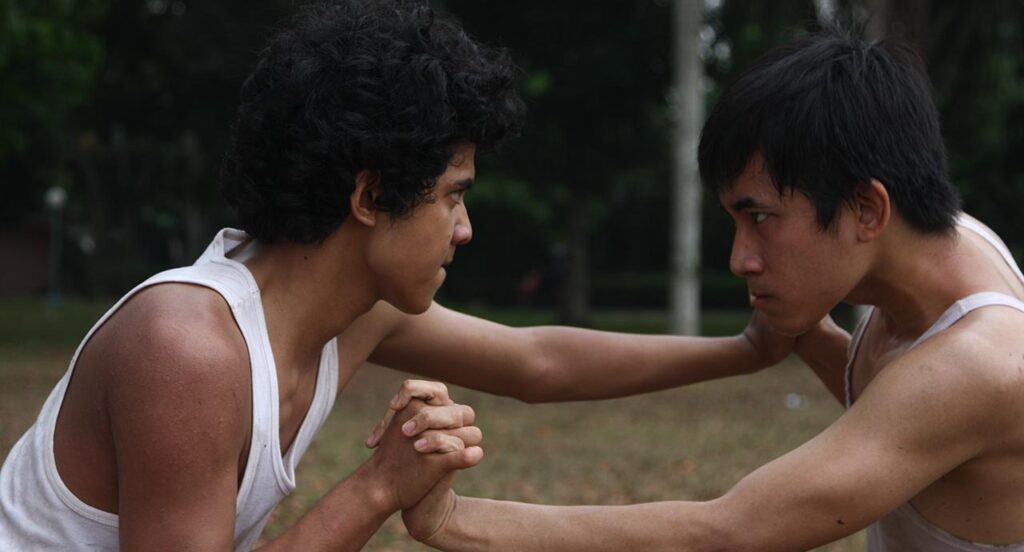Traumatic Pasts: How Do You Remember?



Memory is deeply personal. But it is also the domain of the collective, especially when we consider national historical events. To talk about Southeast Asia is to talk about historical trauma, because historical consciousness has seeped into the very essence of the region, whether its inhabitants are aware or not. This is a common thread that starts emerging as we look at the Southeast Asian short films in competition; whether they be oppression, violence or conflict.
However, each filmmaker has imbued the presentation of the national traumas of their countries with a deeply distinct style. Perhaps it is one of the ways in which they try to come to terms with their history, or maybe it is just another way of immortalizing the past. In particular, Memorial of an Inquiry, The Fox Exploits the Tiger’s Might and The Day the Sky Roared have vastly differing ways of dealing with these traumas.
Memorial of an Inquiry is an experimental, non-linear film that will likely leave you feeling perturbed. The film opens with an x-ray image of veins super imposed over a woman’s unruly hair staring at the sky. Entirely in black and white, the film utilizes a blend of historical archival footage with reenacted, documentary-style footage of a fictional Filipino tribe going about their daily lives. All these seemingly unrelated sequences are strung together by a narrator, speaking of a sense of extreme disorientation and alienation. There is an allusion to the presence of foreigners and colonizers. Pineda articulates the suffering and trauma of colonization by assuming the perspective of the natives, reclaiming the “discovery of the Natives” trope we often see in Western literature where we get the perspective of only the colonizer. In doing so, he is literally giving a voice to the voiceless natives we see onscreen, who have no way of articulating their experiences. Perhaps, this could be linked to the Philippines’ long history of colonization and this is how Pineda chooses to recognize it.
The Fox Exploits the Tiger’s Might, meanwhile, is unapologetic and brazen. It is a coming-of-age tale set in a small town in Indonesia, about two boys coming to terms with their sexuality. The film opens with a sequence of Aseng, one of the two, furiously masturbating in a storeroom. Unrelenting in its portrayal of sex, there is even a close up of the beads of sweat trickling down the side of his face. In this universe, sex is almost always a metaphor for power. Just as sexuality blatantly pervades the characters’ lives, power permeates every interaction. Without giving too much away, power in this universe is dynamic as it shifts between the two boys. In a sense, one embodies the historically oppressive and powerful forces, and the other the historically subjugated in Indonesia’s context. We know where power rests at the start of the film, but it is not so clear by the end; there is a subversion of the conventional power dynamics as the film plays out. Even the title, a well-known Chinese proverb, alludes to this. Ostensibly set in the 1990s, it is perhaps an attempt to capture the spirit of racial politics in Indonesia during a particularly tumultuous period.
At the other end, we have the Day the Sky Roared. Shot in black and white and set against the Jakarta race riots of 1998, it follows a Chinese Indonesian mother trying to get her daughter to safety. Riding along back lanes on a bicycle, violence is hidden from the audience and the trauma is largely understated; there are only a few allusions to the riots such as a single, lingering shot of a burning roof. However, an impending atmosphere of anxiety hangs over the air as the camera, tilted at an angle, follows the mother’s frantic attempts at finding a safe route.
Amidst all of this madness and panic, the child is far removed from the reality of what is happening. Her face is blank, and she wistfully stares at the sky from behind the iron gate of her home, hoping to escape on a spaceship. Slowly and subtly, the perspective shifts to hers. The film then transitions from black and white to colour. In doing so, the director asks us to view with a child’s eyes. There is a certain innocence in the treatment of such a heavy subject matter, infused with fantastical elements. Rather than adopting a conventional linear retelling of the riots, the director focuses the impact of such historical events on the individual psyche.
I have chosen to examine these films because they have presented historical trauma in vastly differing ways. To start speaking about trauma is to start coming to terms with our common history as a region. I believe there remains much to delve and unpack in Southeast Asia’s historical memory, and I am excited to see more about how regional filmmakers deal with these events.


